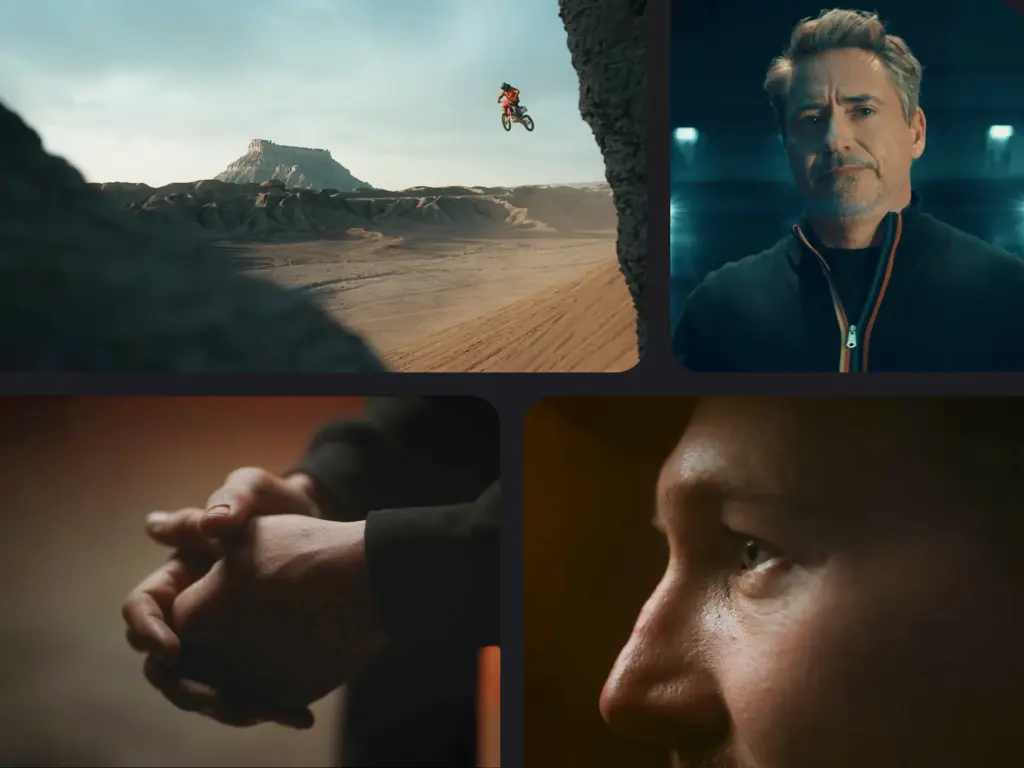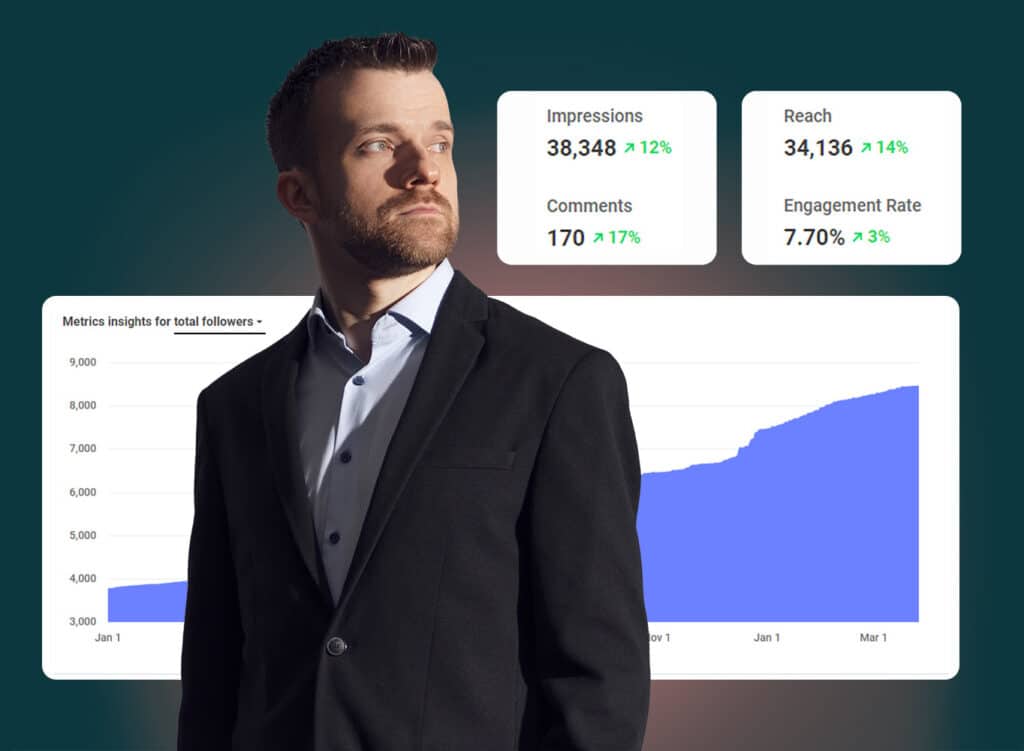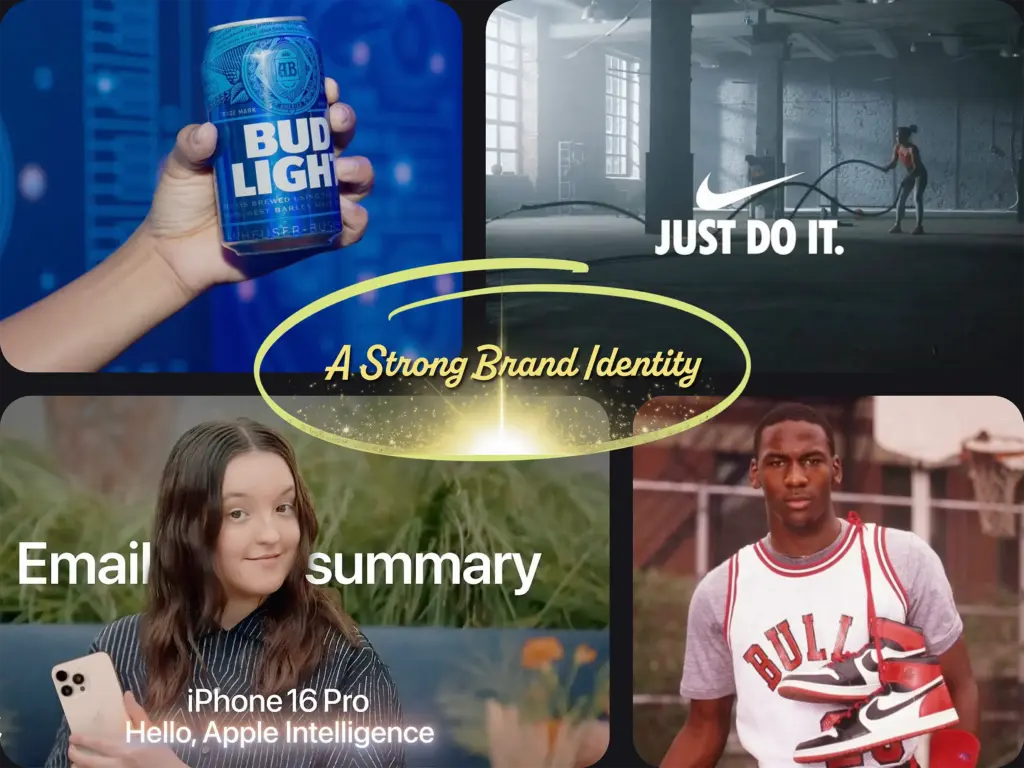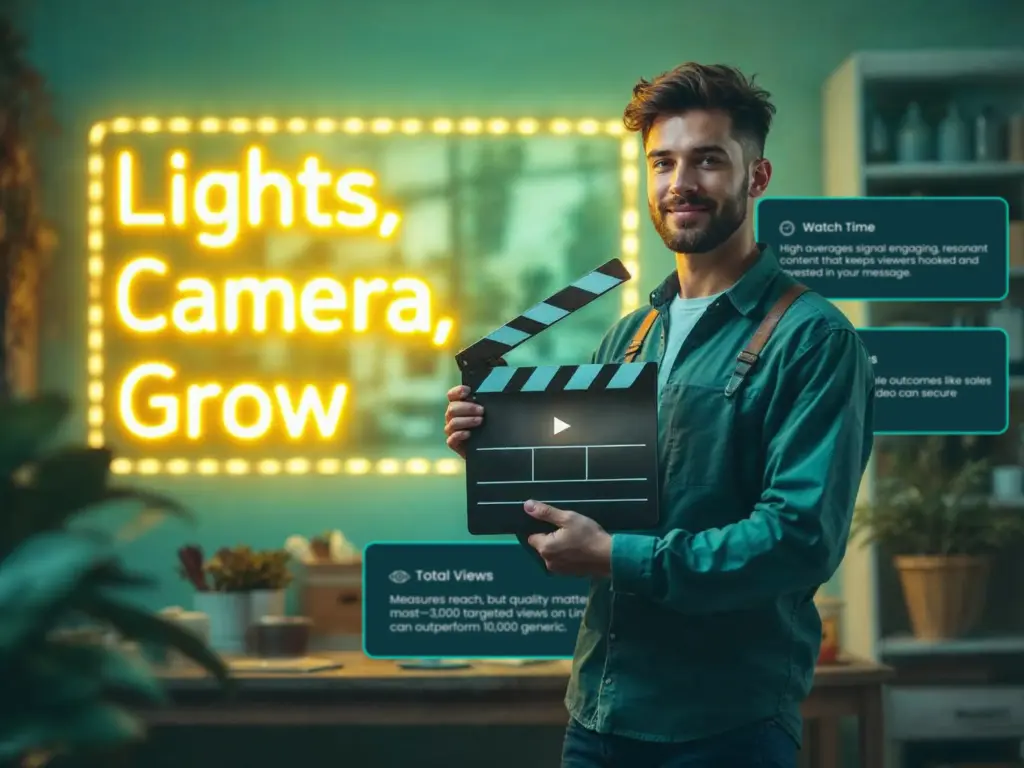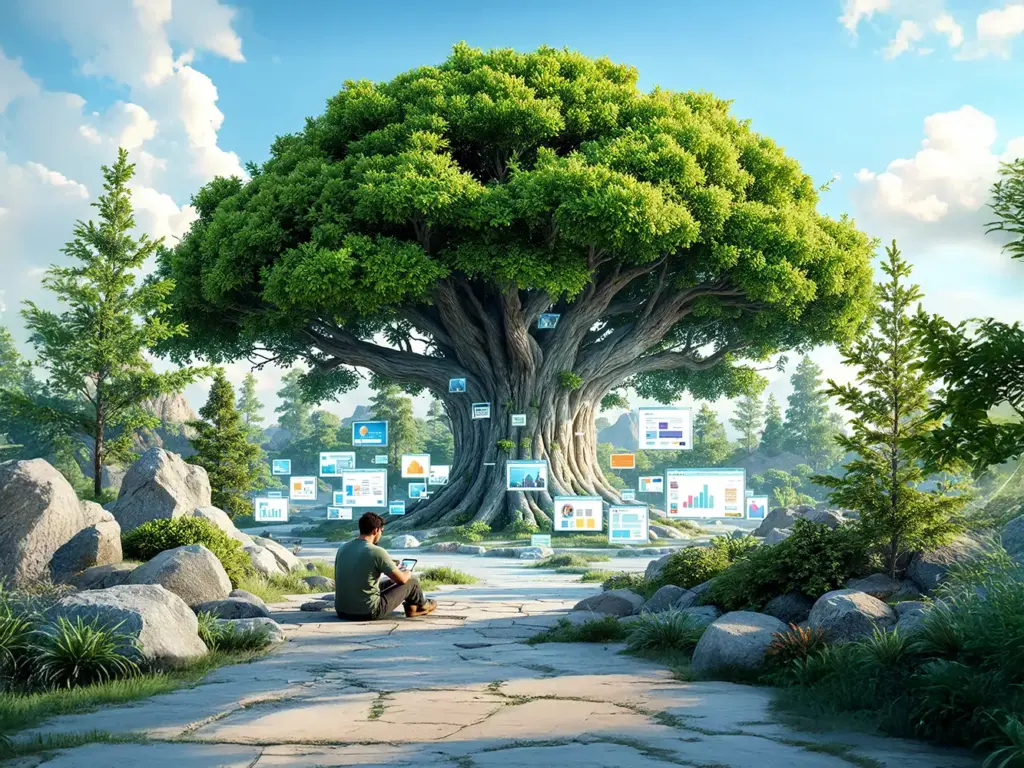B-roll footage is an integral part of any video production. Whether it is a documentary, a television show, music videos, or just a short testimonial clip, filmmakers of all kinds need to understand both A-roll and B-roll footage.
With just a few more scenes and transitions, B-roll footage can make your video more professional and enrich the story you intend to tell. So let’s dive into the topic, find out how to apply it, and answer the question, “What is B-roll?”.
- B-roll is essential for enriching storytelling by providing visual context alongside the main footage, or A-roll.
- Maintain a 60/40 or 70/30 A-roll to B-roll ratio to ensure engaging narratives in videos.
- Utilize varied camera angles like wides, mediums, and close-ups to create compelling B-roll footage.
- Use B-roll effectively for testimonials, storytelling videos, documentaries, and movies to enhance narrative depth.
- Plan your B-roll during pre-production to ensure a comprehensive and cohesive video narrative.
- Excess B-roll footage offers flexibility for editing, providing more options to enhance storytelling.
What Is B-Roll Footage?
There are two types of footage you need to tell a visually compelling story. In the early days, Hollywood films used “A-roll” and “B-roll” to describe their respective roles.
B-roll refers to the accompanying footage intercut into the main shot (also known as “A-roll”) of a video edit. For example, your A-roll could include your interview subject speaking to the camera. Any alternative footage, such as cutaways to surroundings or significant places, will be your B-roll. These cutaways are a great video marketing tool to keep your target audience engaged and help you convey what you are trying to say.
The versatility of using B-roll footage in various types of video productions enhances storytelling through visual interest, building tension, and maintaining viewer engagement.
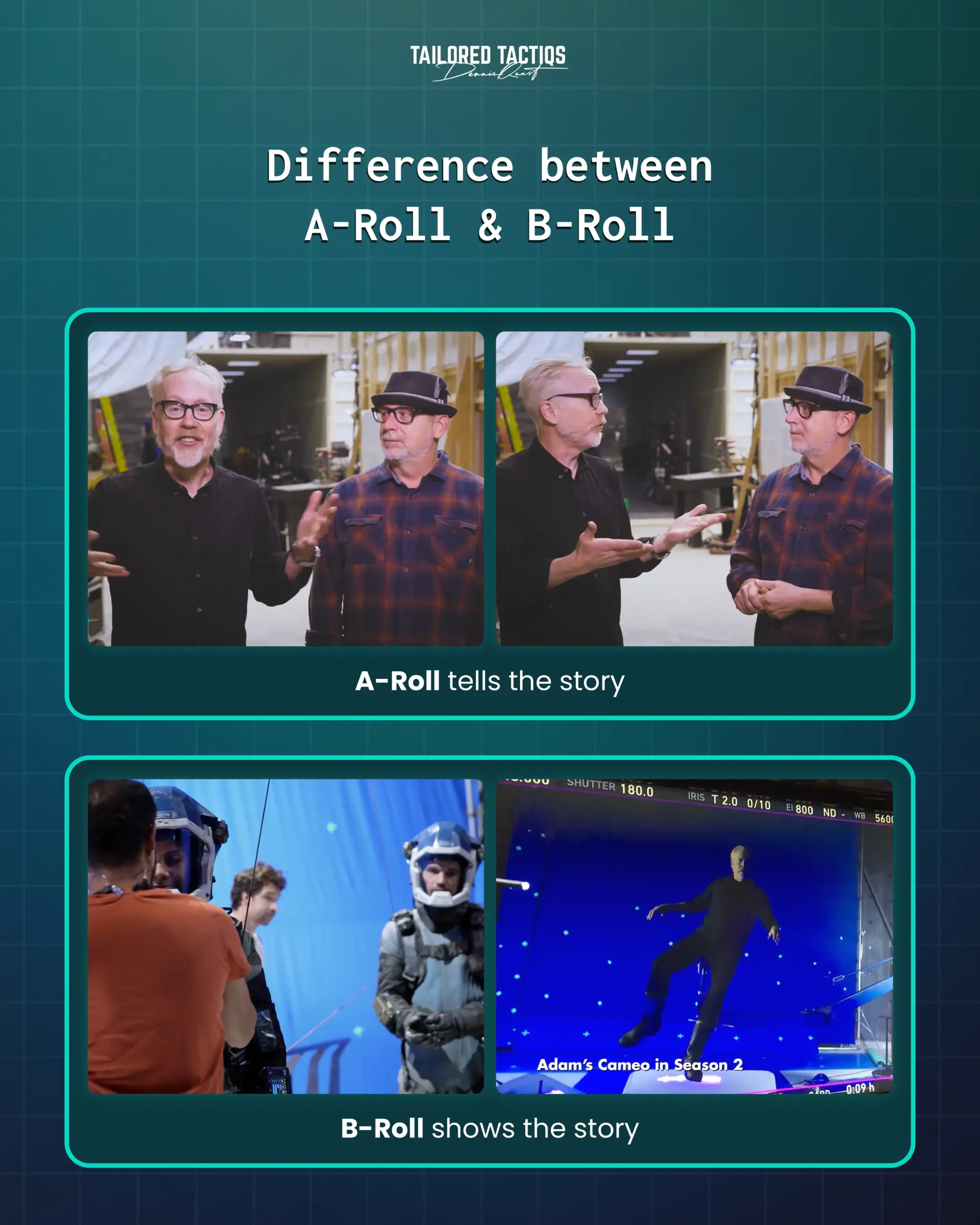
The video below by Adam Savage interviewing the Key Stunt Rigger from The Expanse is an excellent example of how it can look. The “A-roll” is the actual interview, while the B-roll scenes (set footage, final cuts, etc.) add to the context of the conversation.
In simple terms: A-roll tells the story, B-roll shows the story.
While B-roll footage can set the tone of a video and establish characters and the setting, it also breaks up the monotony.
What Are the Most Common Types of B-Roll Video?
1. Undirected Footage
Undirected footage is the video you shoot on-site and can be used to complement your main footage. This type of B-roll footage, as the name implies, is not directed by your character. These could be used for interview videos to show your character’s expressions and hands. Close-up shots can capture the nuances of these expressions and actions, enhancing the storytelling. For a documentary shoot, it can be the everyday activities your character is engaged in.
Utilizing different shots, such as wide shots, medium shots, and close-ups, is crucial to creating a visually compelling narrative.
This interview with Emma Raducanu conducted by Prime Video shows its application perfectly. They used a lot of B-roll footage to fill in the gaps.
2. Stock Footage
Many stock footage websites, like Adobe Stock or Storyblok, will make it easy for you to find the B-roll you need. Stock videos are an essential resource for creating B-roll footage, especially when video creators lack the time or budget to shoot their own. You just need to search for a key phrase to find footage relevant to the video you’re looking to make. While you will usually have to pay an additional fee to use the footage in your project without any attribution, there are times when you can get stock footage for free.
The following is a video I’ve created with parts of stock footage for one of my clients Shohreh Aghdashloo, for Valentine’s Day as a message to her fans:
3. Establishing Shots
An establishing shot in television and filmmaking lets the viewers know the context for the scene. Using different angles in establishing shots can enhance storytelling by providing a richer and more visually engaging introduction. Setting can include both place and time, as well as the time of day and possibly time in history. For example, do you see horses and buggies on the streets or a spaceship flying in the background?
A wide angle shot can establish context within a scene by allowing viewers to grasp the setting and atmosphere, making it particularly effective for showcasing environments such as neighborhoods or towns.
One of my favorite establishing shots is the intro scene in Marvel Studios’ Thor: The Dark World when Thor returns to his home in Asgard.
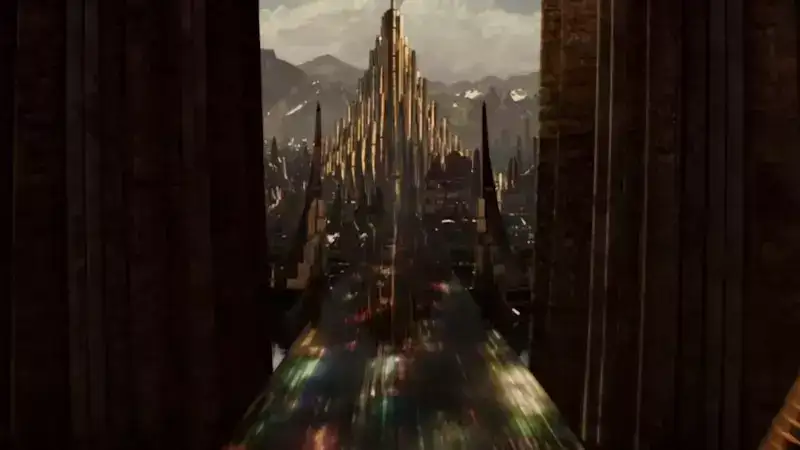
So, technically, an establishing shot is a wide shot (also known as a long shot) or aerial shot showing a lot about the setting for context. For a variety of reasons, establishing shots are different from other shots in a movie:
- The setting shots are a way to set the scene for what’s coming. They don’t have to last more than a few seconds.
- The characters are rarely included in establishing shots. The setting where the action is taking place is what most establishing shots are focused on.
- Establishing shots don’t include dialogue. They are accompanied by music or sound effects.
- Although they might be used to set the mood or emotion that audience members are about to experience, they are not emotionally expressive.
- Stock footage might suffice as B-roll if a shot list requires a basic establishing shot in Los Angeles for example.
How to Shoot B-Roll
You should make sure to get enough B-roll while you are planning what you want to film. Shooting B-roll is a vital component of video production that complements the primary A-roll. You don’t want to be caught up in the editing and post-production process only to realize that your interview subject was not showing what should have been on screen.
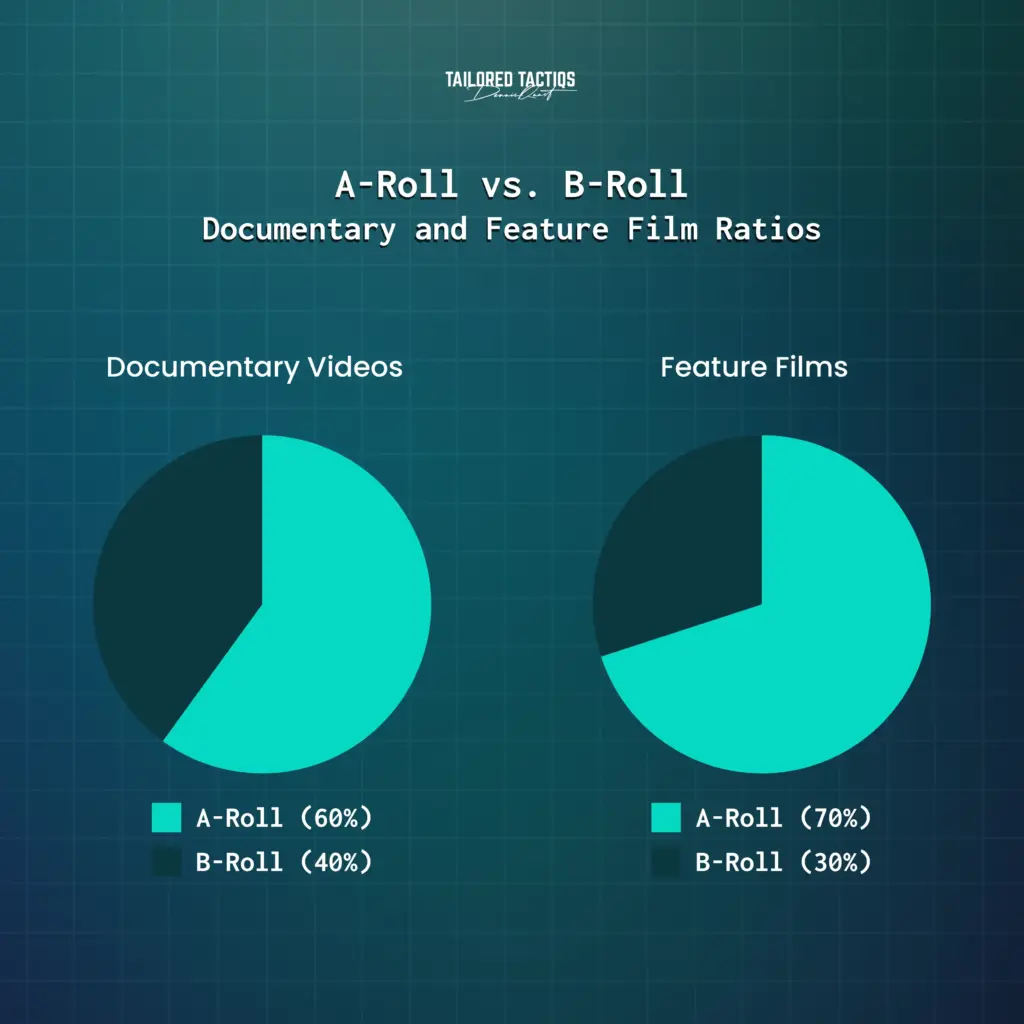
It’s common to use a 60% A-roll to 40% B-roll ratio in documentary-style videos, or a 70% A-roll to 30% B-roll ratio for feature films, striking a balance that keeps the narrative engaging and visually dynamic.
Shooting B-roll footage from a variety of angles enhances the visual storytelling of a video.
1. Planning Ahead
As you would plan every other aspect of your video, so you should also plan your B-roll. Review your script and take note of the scenes that would benefit from B-roll footage. Make sure you know what your main footage is before you start to build around it.
For example, when interviewing a subject in their home, you should plan to capture exit and entry footage and ambient footage, and shots within/of the space. To ensure you tell the entire story, create a list with the “must-haves” and the “nice-to-haves.”
AOD Films’ breathtaking short documentary “Trails of Dust” is a perfect example of employing such B-roll footage.
Upon closer inspection, it contains the same elements of essential B-roll footage as outlined in our infographic below:
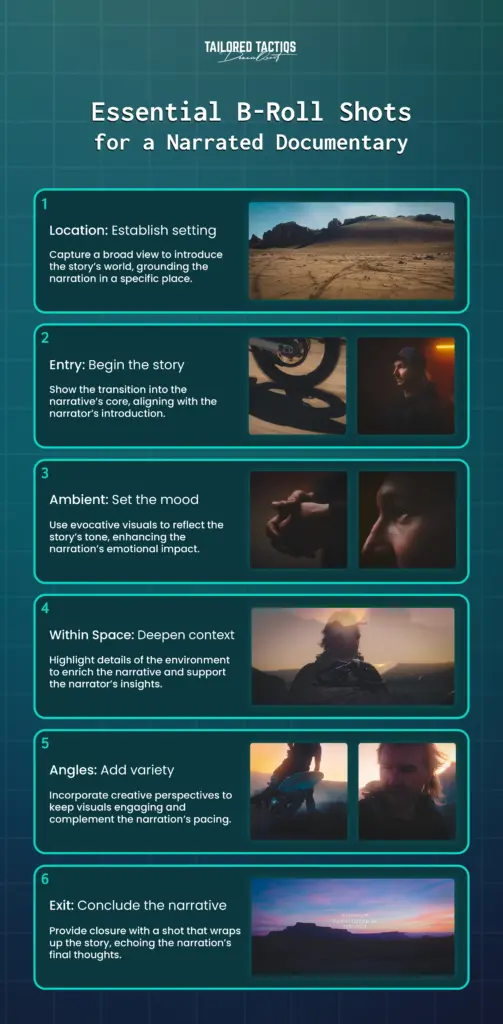
2. Get Different Camera Angles
It’s always a good idea to get multiple shots of the same thing, with or without your subject, to have enough variety in your B-roll footage. Utilizing different shots, such as wide shots, medium shots, and close-ups, is crucial to creating a visually compelling narrative. In case you have to cut parts away, this will cover you.
For educational purposes and to explain the different camera angles, I’m using a few shots from the YouTube documentary series “The Age of A.I.” hosted by Robert Downey Jr. (off-topic, it’s a brilliant series about the evolution of artificial intelligence).
Wide-Angle
This is often an establishing or environmental shot and shows your subject in action. Wide-angle shots can help to place the viewer in your scene.
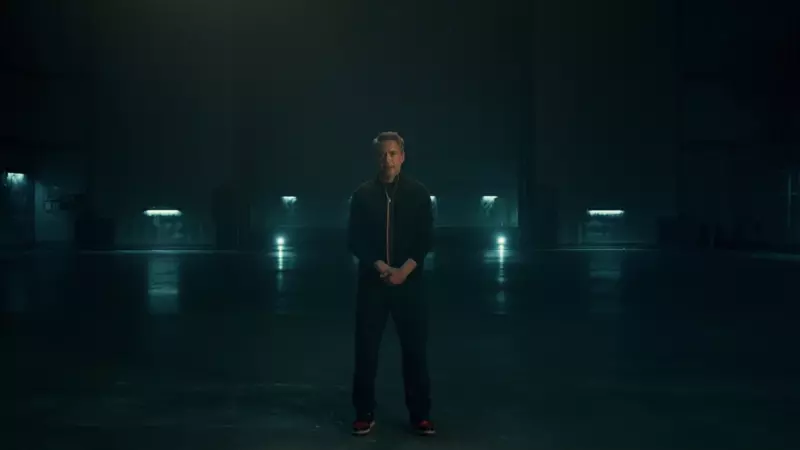
Medium Shot
Also known as a “waist shot,” a medium shot is a portrait taken at a moderate distance. Medium shots are good for subjects who are speaking or moving.
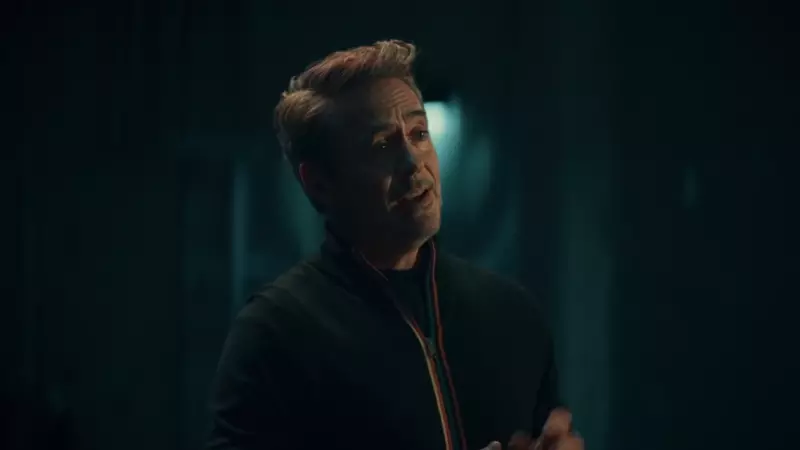
Close-up Shot
Close-ups are the shots that show the details. Close-ups are intimate and highlight subtleties that may otherwise go unnoticed. It frames an actor’s face, making their reaction the focus of the frame.
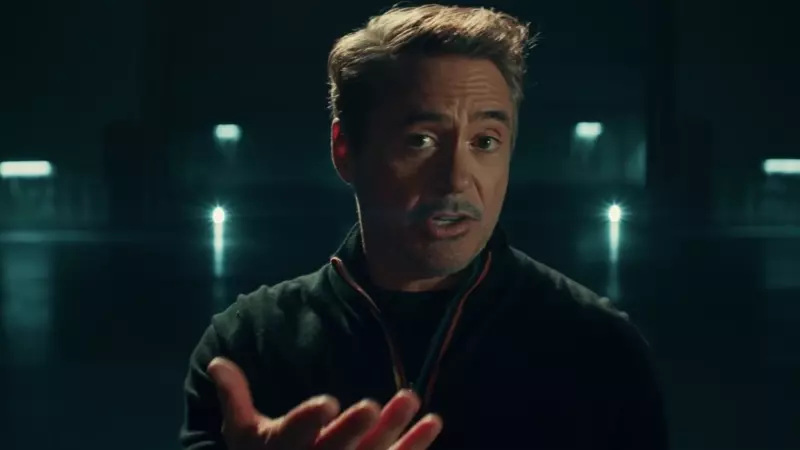
My pro tip: If you are trying to capture a close-up or pan of an important document or an old photograph, use the “Ken Burns Effect” to shoot close-ups and tilts. This will add movement to still images, making them more attractive to the viewer of your video.
In the below example, I’m using a still of the same documentary scene and zoom in from the outer grey border to the blue one at which it will stop.
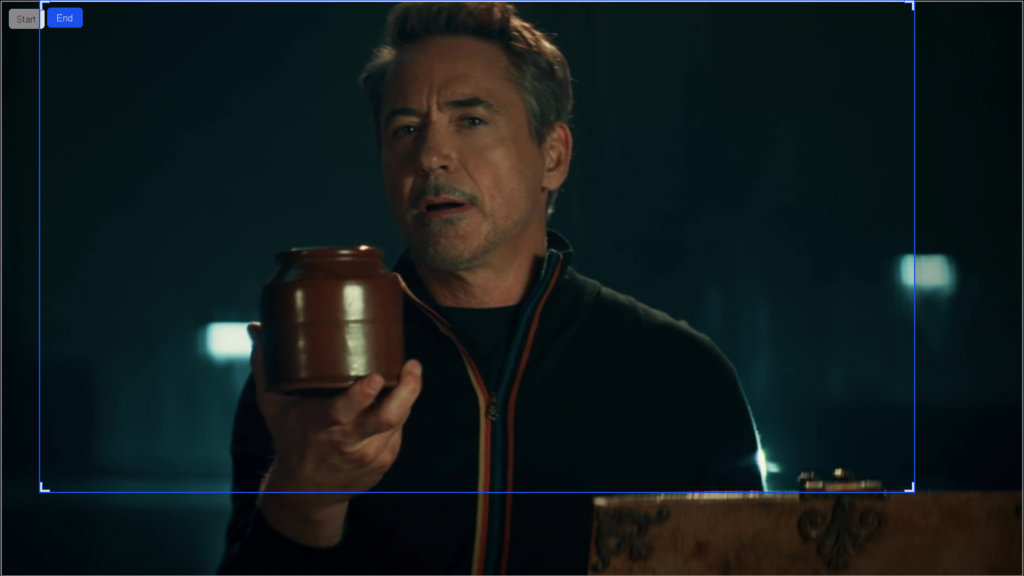
The result is going to look like this:
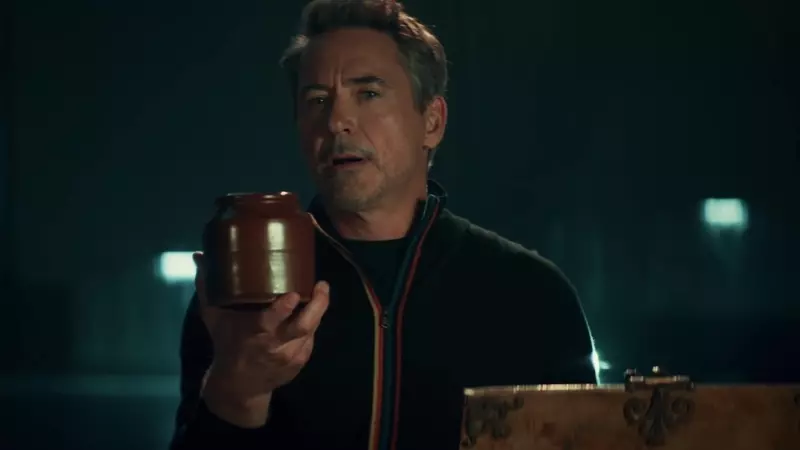
With video editing software, you can achieve the Ken Burns Effect quickly. For example, in Apple’s iMovie and Final Cut Pro, you can find it under “Ken Burns effect,” and in other software, it’s called “Pan and Zoom.”
3. Shoot More Footage than You Need
Keep your camera rolling if you have the chance to capture extra footage. You might catch something even more fascinating than you initially thought. Record some additional timelapse shots of the surroundings and scout the area. B-roll should be high quality and stable to enhance the overall production value, ensuring that it seamlessly integrates with the primary footage and elevates the final video.
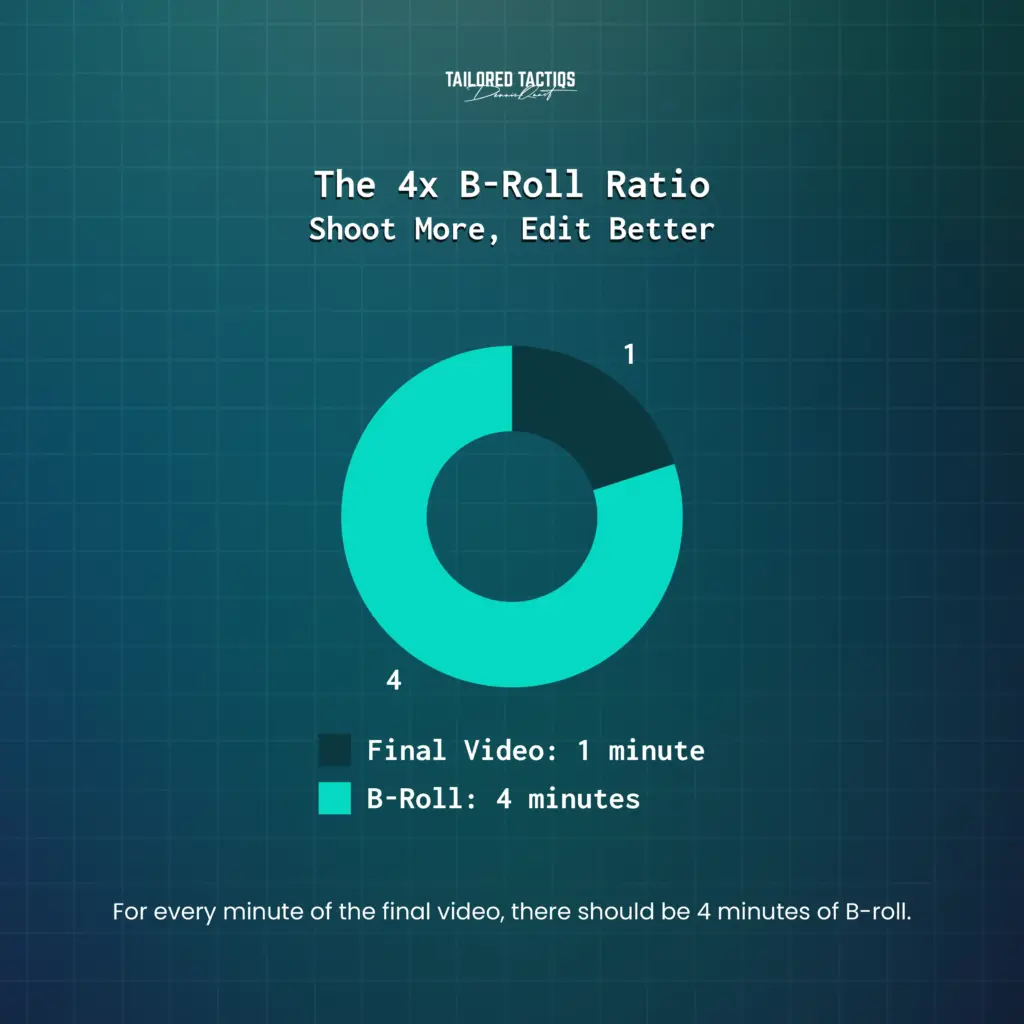
Make sure you have enough B-roll for at least four times the length of your final video creation. For example, you should shoot 4 minutes of B-roll if the interview ends in a minute. Of course, you won’t use it all, but it’s essential to have options. Extra footage is crucial for enhancing storytelling and providing editing flexibility.
Editing B-Roll Footage
Editing B-roll footage is an essential part of the post-production process. It involves incorporating the secondary footage into the primary footage to create a cohesive narrative.
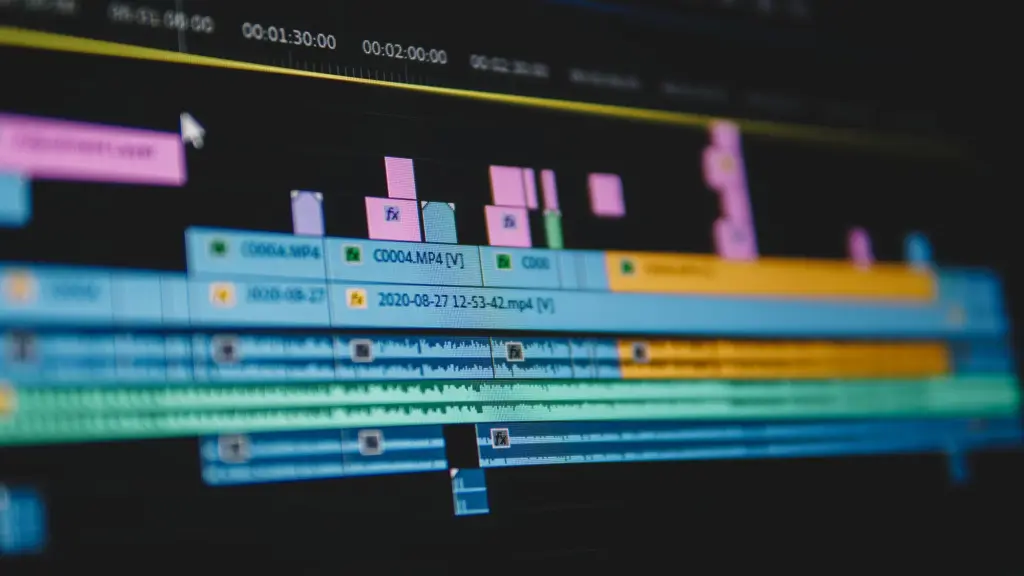
The editor must consider the pacing, tone, and visual flow of the story when editing B-roll footage. For instance, B-roll can be used to break up long segments of A-roll, providing visual relief and maintaining the viewer’s interest. It can also be used to cover up cuts or transitions in the primary footage, ensuring a smooth and seamless viewing experience. Additionally, B-roll footage can help to establish the setting, convey the passage of time, or provide additional context to the main story.
By carefully selecting and editing B-roll footage, editors can enhance the overall quality and impact of the final video, making it more engaging and visually appealing for the audience.
Best Use Cases for B-Roll
I can’t stress it enough. B-roll adds context and layers to storytelling. A scene that captures the subject entering or leaving a location or shots of an exterior location directs the viewer’s attention into and out of a scene. Pre-production planning for feature films or short films is crucial, including the need for detailed storyboards and B-roll footage to enhance the narrative quality.
For those aspiring to become a successful documentary filmmaker, the journey and skills required highlight the need for practice and patience. Let’s take a look at the common use cases for your B-roll.
1. Testimonials
The number one type of video you want to use your B-roll for is testimonials.
According to a survey by Wyzowl, 2 out of 3 people say they’d be more likely to purchase after watching a testimonial video demonstrating how a business, product, or service had helped another person like them. So, video testimonials can be a great way to build your customer base and help customers make better purchasing decisions. B-roll shots are essential in enhancing visual storytelling for testimonials by providing context and variety, making the narrative more engaging. This high-production video by Mailchimp uses a lot of B-roll footage.
2. Storytelling Videos
The storytelling video is a powerful way to connect emotionally with your audience and communicate your brand. With engaging visuals, these videos highlight core values and purpose. They offer more than just a product, service, or experience.
Supplemental footage, such as B-roll, plays a crucial role in enhancing storytelling videos by providing context and visual support, making the overall production more engaging and immersive for viewers.
It doesn’t always have to be a high-quality production with a big camera team. For example, I’ve created the following online video for a behind-the-scenes glimpse of a new Hollywood film for Shohreh Aghdashloo’s social media channels. All of the content came from a smartphone and was recorded on the fly during the shooting.
3. Documentaries
It is not often that the camera stays on top of a shot of someone talking directly to the camera, as you might have noticed in a documentary. Instead, you may have a shot of someone talking and then cut to the B-roll that supports the story. B-roll footage is often used to cover pauses or awkward moments in A-roll, ensuring a smoother and more engaging viewing experience.
Documentary filmmaking involves various techniques and storytelling methods essential for creating engaging documentary content. These include the use of B-roll, interviews, and narrative structures to effectively convey the subject matter and enhance the viewer’s experience.
Documentaries must set the scene for the story they will be telling viewers and convey that story with a level of authority. For example, this Netflix documentary “Our Planet” starts with numerous beautiful establishing shots or “aerial B-roll” of the planet from space and vast forests to introduce the viewer to the episode.
4. Movies & Television
The fourth most common case is trailers, and generally in movies and television. A trailer is packed with lots of B-roll footage to establish the characters, conflicts, and action in a short time. Transitional footage plays a crucial role in facilitating smooth transitions between scenes or segments, enhancing the storytelling process. It brings excitement, turns up the emotion, and is meant to increase video views and the conversion rates of your content marketing strategy.
Here is an eye-popping movie trailer example that generates interest in the sci-fi action film “The Matrix Resurrections.”
Conclusion
B-roll is a great way to establish your story in videos and build a personal archive of unutilized footage you can draw from or use as a fallback. It can be used to add value to a project or inspire a new one. However, it’s best to keep it if you own it.
B roll examples in popular media show how such footage is utilized to create a sense of place and enrich storytelling. For instance, establishing shots of cityscapes or nature scenes can set the ambiance and context for the main narrative.
We hope this article answered your question, “What is a B-roll” and how you can apply it. For further information about Video Marketing strategy, we have prepared this guide for you.
